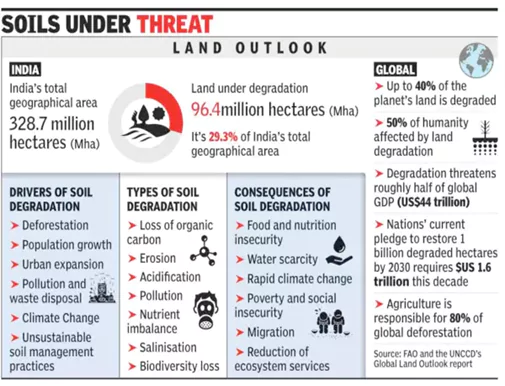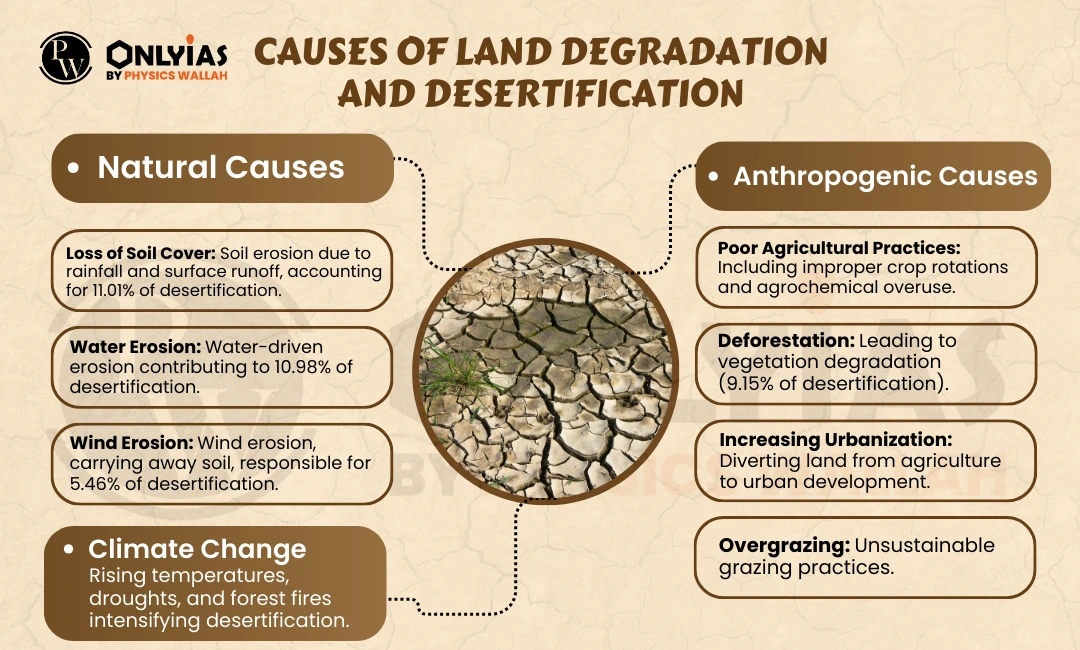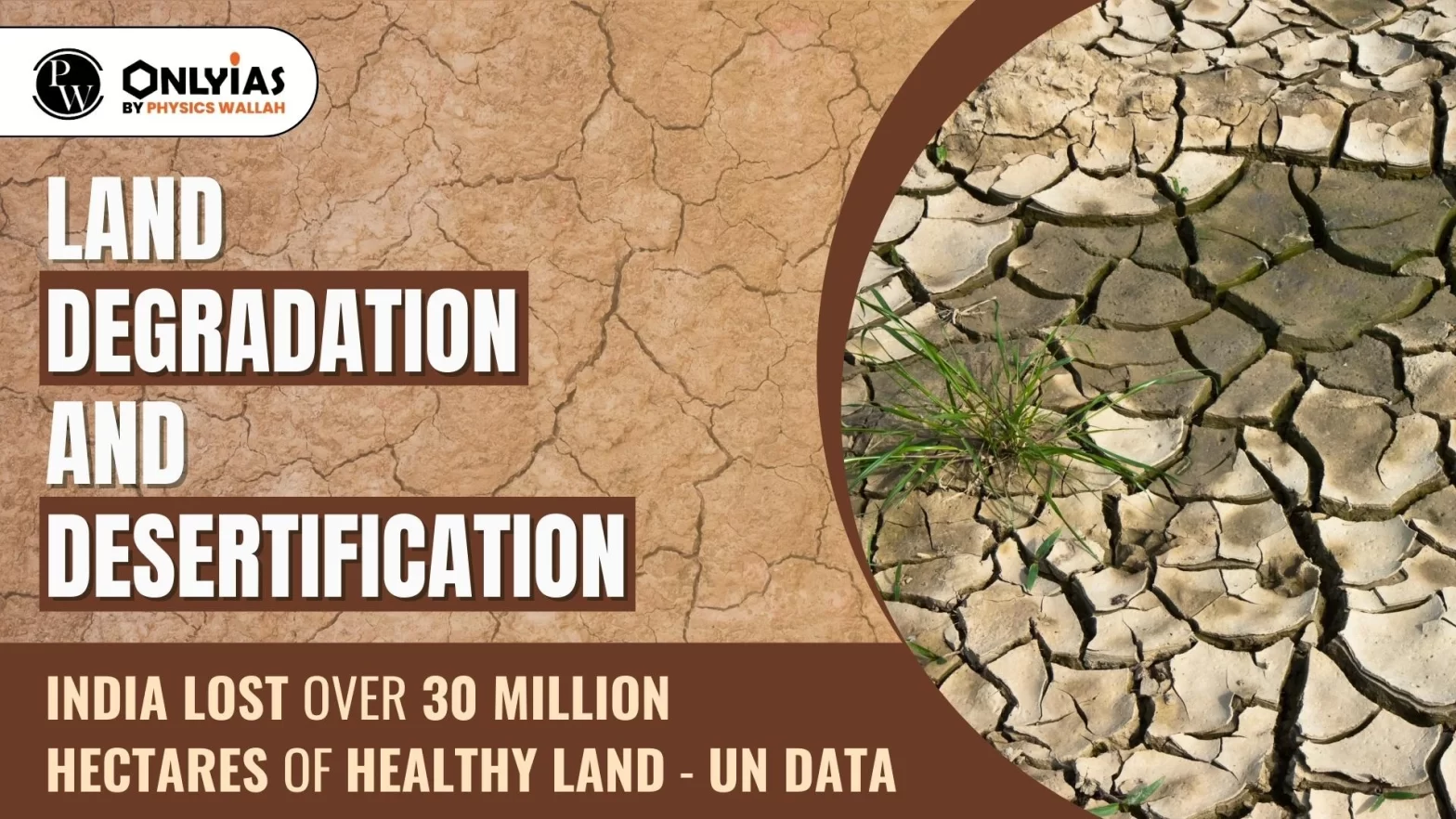Context: :
What is land degradation?
- Land degradation is the result of human-induced actions which exploit land, causing its utility, biodiversity, soil fertility, and overall health to decline.
- Land degradation within dry land regions (arid, semi-arid and dry sub-humid regions) is termed as ‘desertification’.

What are the causes of land degradation and desertification?
- Natural Causes:
- Loss of Soil Cover: Soil erosion due to rainfall and surface runoff, accounting for 11.01% of desertification.
- Water Erosion: Water-driven erosion contributing to 10.98% of desertification.
- Wind Erosion: Wind erosion, carrying away soil, responsible for 5.46% of desertification.
- Anthropogenic Causes:
- Poor Agricultural Practices: Including improper crop rotations and agrochemical overuse.
- Deforestation: Leading to vegetation degradation (9.15% of desertification).
- Increasing Urbanization: Diverting land from agriculture to urban development.
- Overgrazing: Unsustainable grazing practices.
- Climate Change: Rising temperatures, droughts, and forest fires intensifying desertification.

Impacts of Land Degradation and Desertification
- Economic Impact: Land degradation caused a loss of over 2% of India’s GDP in 2014-15 (TERI).
- Environmental Impact:
- Soil Erosion: Topsoil detachment by water, ice, waves, or wind.
- Loss of Fertility: Due to unscientific farming practices and chemical inputs.
- Salinity/Alkalinity: Caused by over-irrigation or excessive rainfall.
- Water Scarcity: Dryland population vulnerable to water stress and increased drought (178 million projected by 2050).
- Potential Impacts on Human Health:
- Malnutrition: Reduced food and water supplies.
- Water- and Food-Borne Diseases: Poor hygiene and lack of clean water.
- Respiratory Diseases: Atmospheric dust from wind erosion and air pollutants.
- Infectious Diseases: Impacting public health as populations migrate.
- Rights of Indigenous People:
- Insecure land tenure hampers the ability of people and indigenous groups to combat climate change, further endangering their rights and livelihoods.
Government Measures to Combat Land Degradation and Desertification
- Desertification and Land Degradation Atlas: Published by Space Applications Centre (SAC) of the Indian Space Research Organisation.
- Estimated land degradation and desertification in India: 97.84 million hectares in 2018-19.
- Offers state-wise information on degraded land to aid restoration planning.
- Online Portal for Visualization: Developed in collaboration with Space Application Center (SAC), Ahmedabad.
- Allows visualization of degraded land areas and the processes causing degradation.
- Centre of Excellence at ICFRE Dehradun: Envisioned at the Indian Council for Forestry Research and Education (ICFRE), Dehradun.
- Focuses on South-South Cooperation for knowledge sharing and best practices.
Also read: Climate Smart Agriculture (CSA)
Way forward
- Implement comprehensive land use planning to balance stakeholder needs while preserving land resources.
- Promote practices like terrace farming and rainwater harvesting for land restoration, increased crop yields, reduced emissions, and carbon sequestration.
- Align Mahatma Gandhi National Rural Employment Guarantee Scheme (MGNREGS) with Pradhan Mantri Krishi Sinchayee Yojana (PMKSY) to treat 30% more land.
- China’s Great Green Wall: China’s Three-North Shelterbelt Program combats desertification and dust storms with large-scale non-native forest strips in the Gobi Desert region.
Conclusion:
UNCCD’s Data Dashboard reveals a concerning reality for India, with the nation losing more than 30 million hectares of healthy land—highlighting a serious problem of land degradation and desertification that needs urgent attention and action.
| Prelims Question (2016)
What is/are the importance/ importances of the ‘United Convention to Combat Desertification (UNCCD)’?
1. It aims to promote effective action through innovative national programmes and supportive international partnerships
2. It has a special/particular focus on South Asia and North Africa regions, and its Secretariat facilitates the allocation of major portion of financial resources to these regions.
3. It is committed to bottom-up approach, encouraging the participation of local people in combating the desertification.
Select the correct answer using the code given below.
(a) 1 only
(b) 2 and 3 only
(c) 1 and 3 only
(d) 1, 2 and 3
Ans: (c) |
![]() 27 Oct 2023
27 Oct 2023



